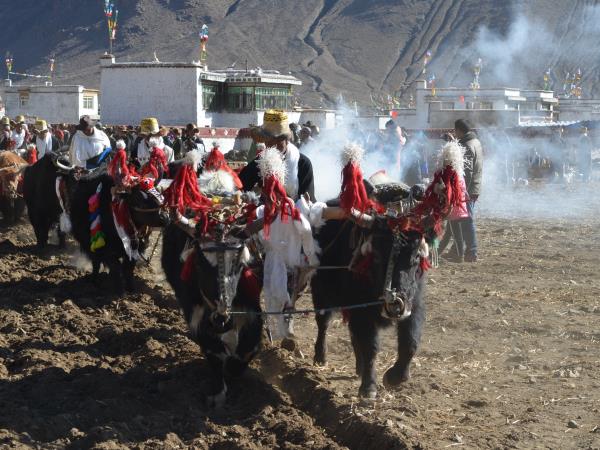In depth tour of Tibet








Description of In depth tour of Tibet
Check dates, prices & availability
Travel guides
The ‘Roof of the World’ has a mystic allure, and there is no question that Tibet is truly beautiful inside and out. But having been occupied by China ...
Asia is massive: a whopping great sprawl of a continent with some 4.5 billion people living across it – that’s more than the population of every other...
Responsible Travel
As the pioneers of responsible tourism, we've screened this (and every) vacation so that you can travel knowing it will help support the places and people that you visit, and the planet. Read how below.
Planet
The ecosystem in Tibet is fragile and local guides don’t have the environmental awareness needed to keep this ecosystem pristine. We take matters into our own hands by ensuring we take any litter with us and dispose of it responsibly in a big town. It is wise to bring a reusable water bottle that can be re-filled and if bringing snacks, we try and avoid excessive packaging. We are careful about where we hike also, as erosion and damage to plants are serious threats to the environmental health of the Himalayas. We think carefully about bringing excessive gifts for locals and children as not only can it contribute to begging and make locals more reliant on handouts but it can also be detrimental to the environment. If bringing gifts, we avoid anything made of plastic that will harm the environment when discarded.Wildlife is also under threat in Tibet. If we see any products made from wild animals, especially endangered species, we inform our group members not to buy these and we will be sure to take photographs and send them to WWF or the International Campaign for Tibet. Products made from the parts of endangered species include: horns of the Tibetan Antelope, paws of the Himalayan brown bear, skins of the snow leopard and tiger and various medical products.
People
There are many ways in which we can ensure we travel responsibly in Tibet. First and foremost, we must respect local customs and culture. Tibetans are extremely religious people and they expect foreigners to respect their simple customs. We must walk clockwise around Buddhist religious sites and within nunneries or monasteries, take off hats, refrain from smoking, make sure we don’t touch figures and we cannot use flash photography inside nunneries or monasteries. Ceremonies must be quietly observed and respected and we should not interrupt these, nor should we jump queues of pilgrims within monasteries. We must always dress appropriately when visiting any holy or religious sites and avoid physical contact with monks and nuns. It is very important not to touch the heads of monks or nuns or point our feet towards them. Tibet also have burial rituals called sky or celestial burials. These burials are very sacred and private and visitors are not welcome. It is actually believed by some Tibetans that photographs can steal their souls and, in any circumstance, we should ask before taking photographs.We aim to support Tibetan people, by buying from Tibetan shops and stalls, as well as restaurants and tea stalls. Eating Tibetan food rather than imported Chinese food, is always a good idea and avoiding buying from vendors whose goods are of unreasonably high prices will also benefit Tibetans, as often, they are made to pay increased prices for goods also. When buying precious items such as carvings and woven cloth, we always think about the amount of work that has gone into making the item and pay a fair price to the Tibetan craftsman.
Sometimes, we may be offered to buy antiques, family heirlooms and religious items, all of which are usually sold secretly. If someone approaches us with an item and is acting secretive and coy, we must avoid the situation. We may find ourselves in a bit of a catch twenty-two, as families often sell these items as means of putting food on the table but it is important that items that contribute to the local culture, stay in Tibet. Many artistic treasures in Tibet have already been destroyed, so it is always wise to try and find other ways of supporting and helping Tibetans without contributing to the stripping of their culture.
We think carefully about bringing excessive gifts for locals and children as it can contribute to begging and locals may become more reliant on handouts.Playing games with children and spending time talking with the adults, is a more appropriate way to show we care.
We always work with local guides where possible as their deep involvement in their own countries means that they are able to offer greater insights than a western leader, and means that we keep our carbon footprint small and ensure that money stays within local communities. All of our guides in Tibet are Tibetan people and will be able to share raw and honest knowledge and real stories, stretching far beyond the common-known information of the region.
Popular similar vacations
Bejing to Lhasa tour, by train
From £1600 - £2300 13 days excluding flights
Beijing to Lhasa on the famous sky train
Tibet culture tour & Everest base camp
From £1799 9 days excluding flights
Meet the people, heritage & stunning landscapes of Tibet
Central Tibet cultural tour, 6 days
From US $799 - US $879 6 days excluding flights
Explore the cultural center area of Tibet











